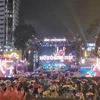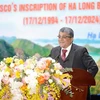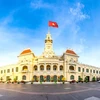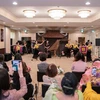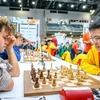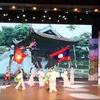 The exhibition, which was opened in Hanoi on October 3, displays 130 photos both colour and black-and-white. The photos, taken by world-renowned German photographer Thomas Billhardt – captured images of the Vietnamese capital city in the period from 1967 to 1975. The event is co-organized by Goethe Institute, Camera Work, Nha Nam Publisher, and Manzi Art Space. It will go on at the Manzi Exhibition Space at No. 2 Hang Bun Lane and at the Manzi Art Space at 14 Phan Huy Ich Street from October 3 to November 15. The photos were taken during Billhardt’s trips to Vietnam. They provide viewers with an unfiltered view into the daily activities of local people in Hanoi. (Photo: VietnamPlus)
The exhibition, which was opened in Hanoi on October 3, displays 130 photos both colour and black-and-white. The photos, taken by world-renowned German photographer Thomas Billhardt – captured images of the Vietnamese capital city in the period from 1967 to 1975. The event is co-organized by Goethe Institute, Camera Work, Nha Nam Publisher, and Manzi Art Space. It will go on at the Manzi Exhibition Space at No. 2 Hang Bun Lane and at the Manzi Art Space at 14 Phan Huy Ich Street from October 3 to November 15. The photos were taken during Billhardt’s trips to Vietnam. They provide viewers with an unfiltered view into the daily activities of local people in Hanoi. (Photo: VietnamPlus) Children playing at a construction site on Dinh Tien Hoang street, near Hoan Kiem (Returned Sword) Lake in the centre of Hanoi, in 1975. The photos displayed at the exhibition have been selected from the huge collection of Billhardt, a special photographer of the then German Democratic Republic. Billhardt loved photography as a child, being raised by a photographer mother. He graduated from the University of Graphics and Book Design in Leipzig in 1963. When he made the first of his 12 trips to Hanoi four years later, he never imagined that it would give birth to an association lasting more than five decades. (Photo: VietnamPlus)
Children playing at a construction site on Dinh Tien Hoang street, near Hoan Kiem (Returned Sword) Lake in the centre of Hanoi, in 1975. The photos displayed at the exhibition have been selected from the huge collection of Billhardt, a special photographer of the then German Democratic Republic. Billhardt loved photography as a child, being raised by a photographer mother. He graduated from the University of Graphics and Book Design in Leipzig in 1963. When he made the first of his 12 trips to Hanoi four years later, he never imagined that it would give birth to an association lasting more than five decades. (Photo: VietnamPlus)  Thomas Billhardt is the most special photographer of the German Democratic Republic, whose photos about the American War in Vietnam at the end of 1960s earned him the worldwide fame. The photographer, who was born in 1937, said he had special affection with Vietnam after setting foot in the Asian country for the first time in 1962. He photographed the joyful moment of welcoming a child born in the wartime, captured American pilots in camps, crowds bicycling in the rain, outdoor drawing classes with barefooted pupils, the innocent happy faces of children and a stadium with football crowds lost in passionate cheers. All these visual notes make a symphony about life steeped in hardship but brimming with care and love. (Photo: VietnamPlus)
Thomas Billhardt is the most special photographer of the German Democratic Republic, whose photos about the American War in Vietnam at the end of 1960s earned him the worldwide fame. The photographer, who was born in 1937, said he had special affection with Vietnam after setting foot in the Asian country for the first time in 1962. He photographed the joyful moment of welcoming a child born in the wartime, captured American pilots in camps, crowds bicycling in the rain, outdoor drawing classes with barefooted pupils, the innocent happy faces of children and a stadium with football crowds lost in passionate cheers. All these visual notes make a symphony about life steeped in hardship but brimming with care and love. (Photo: VietnamPlus)  A bomb shelter on a Hanoi street through the lens of Billhardt. He first came to the capital city with a group of movie makers from the German Democratic Republic (GDR) in 1967 to film a documentary about American soldiers captured in Hanoi amidst the infamous Operation Rolling Thunder, the bombing blitz unleashed by the U.S. against the North of Vietnam. Seeing the devastation of the war, the bomb craters, destroyed buildings, and the sounds of air raids and sirens calling for people to take cover, he was deeply moved and decided to tell the story of Hanoi and its people with a "photo chronicle." (Photo: VietnamPlus)
A bomb shelter on a Hanoi street through the lens of Billhardt. He first came to the capital city with a group of movie makers from the German Democratic Republic (GDR) in 1967 to film a documentary about American soldiers captured in Hanoi amidst the infamous Operation Rolling Thunder, the bombing blitz unleashed by the U.S. against the North of Vietnam. Seeing the devastation of the war, the bomb craters, destroyed buildings, and the sounds of air raids and sirens calling for people to take cover, he was deeply moved and decided to tell the story of Hanoi and its people with a "photo chronicle." (Photo: VietnamPlus)  Photos taken during the American war in Vietnam in the late 1960s gave Billhardt world renown and critical recognition. His photos held up a mirror to the world while strengthening hope. They tell stories of the world’s social inequalities, of poverty, of suffering, of war, but also of the life and laughter of the people who live in it. Between 1962 and 1975, the photographer travelled to the war-ravaged country six times and has returned several times since then. His works stirred empathy and solidarity across national borders. Billhardt, who struck up friendship with many of his subjects, said his love for the Southeast Asian country is not about houses or roads, it is about Vietnamese people. (Photo: VietnamPlus)
Photos taken during the American war in Vietnam in the late 1960s gave Billhardt world renown and critical recognition. His photos held up a mirror to the world while strengthening hope. They tell stories of the world’s social inequalities, of poverty, of suffering, of war, but also of the life and laughter of the people who live in it. Between 1962 and 1975, the photographer travelled to the war-ravaged country six times and has returned several times since then. His works stirred empathy and solidarity across national borders. Billhardt, who struck up friendship with many of his subjects, said his love for the Southeast Asian country is not about houses or roads, it is about Vietnamese people. (Photo: VietnamPlus)  The love prompted him to return the country in 1999, looking for those portrayed in his photographs to check out their post-war lives. He organized an open exhibition at the Dong Kinh Nghia Thuc Square, a busy place in Hoan Kiem district that frequently hosts various festivities. He said he wanted to organize a photo exhibition in the heart of Hanoi to be able to observe, remember and try to find people. Billhardt said he yearned to return to Vietnam when the COVID-19 crisis was over. He was excited to see how the country had developed in recent decades. In 2019, Billhardt started organising a tour to Vietnam to visit places that he had been to during the war. But the number of people registering for the tours was so high that he has to plan more trips in the future. (Photo: VietnamPlus)
The love prompted him to return the country in 1999, looking for those portrayed in his photographs to check out their post-war lives. He organized an open exhibition at the Dong Kinh Nghia Thuc Square, a busy place in Hoan Kiem district that frequently hosts various festivities. He said he wanted to organize a photo exhibition in the heart of Hanoi to be able to observe, remember and try to find people. Billhardt said he yearned to return to Vietnam when the COVID-19 crisis was over. He was excited to see how the country had developed in recent decades. In 2019, Billhardt started organising a tour to Vietnam to visit places that he had been to during the war. But the number of people registering for the tours was so high that he has to plan more trips in the future. (Photo: VietnamPlus)  The 83-year-old photographer, who is still in a good health, is scheduled to talk to the audience in mid-October. A photo book on Hanoi during 1967-1975, published by the Goethe Institute and the Nha Nam Publishing House, will make its debut around this time, along with a film screening. Billhardt also unveiled his upcoming project to take photos of the Alexanderplatz, a large public square and transport hub in Berlin, where he produced a lot of photos for a photo book published in 1958. The project is to show how the area has changed and developed over the decades. He said he wants to come back to Vietnam to do something similar, then he can show people how the country has been changed since the days he first came here. (Photo: VietnamPlus)
The 83-year-old photographer, who is still in a good health, is scheduled to talk to the audience in mid-October. A photo book on Hanoi during 1967-1975, published by the Goethe Institute and the Nha Nam Publishing House, will make its debut around this time, along with a film screening. Billhardt also unveiled his upcoming project to take photos of the Alexanderplatz, a large public square and transport hub in Berlin, where he produced a lot of photos for a photo book published in 1958. The project is to show how the area has changed and developed over the decades. He said he wants to come back to Vietnam to do something similar, then he can show people how the country has been changed since the days he first came here. (Photo: VietnamPlus)  Billhardt’s photos captured moments that cannot be reproduced, which made us forget fear and the war, and bring us a hope for peace, said the director of the Goethe Institute. The photographer wanted to show the world the photos he took in Vietnam so they would know exactly what was going on. Then they would understand and love Vietnam, just like him. He decided that his wartime photography would focus on people going about their daily lives, busy working and getting ready to fight at the same time. Billhardt’s photos reflect crowds cycling under pouring rain, happy faces of barefoot children attending an outdoor painting class, and a stadium filled with people cheering and laughing as they watched football match and many scenes of love and care, powerfully contrasted and resisted the extreme violence of war. (Photo: VietnamPlus)
Billhardt’s photos captured moments that cannot be reproduced, which made us forget fear and the war, and bring us a hope for peace, said the director of the Goethe Institute. The photographer wanted to show the world the photos he took in Vietnam so they would know exactly what was going on. Then they would understand and love Vietnam, just like him. He decided that his wartime photography would focus on people going about their daily lives, busy working and getting ready to fight at the same time. Billhardt’s photos reflect crowds cycling under pouring rain, happy faces of barefoot children attending an outdoor painting class, and a stadium filled with people cheering and laughing as they watched football match and many scenes of love and care, powerfully contrasted and resisted the extreme violence of war. (Photo: VietnamPlus)  Billhardt decided that his wartime photography would focus on people going about their daily lives, busy working and getting ready to fight at the same time. He travelled to Vietnam six times between 1962 and 1975, and has returned several times since then. The photos taken during these trips have been published in four illustrated books, Pilots in Pajamas (1968), Longing for Peace: Vietnam (1973), Hanoi on the Eve of Peace (1973), and Faces of Vietnam (1978). The free entry exhibition Hanoi 1967 – 1975, which is organised by Manzi Art Art Space in collaboration with the Goethe Institute Vietnam, Camera Work, is taking place at both Manzi, 2 Hang Bun Alley and 14 Phan Huy Ich Street, Ba Dinh district, Hanoi, until November 15. (Photo: VietnamPlus)
Billhardt decided that his wartime photography would focus on people going about their daily lives, busy working and getting ready to fight at the same time. He travelled to Vietnam six times between 1962 and 1975, and has returned several times since then. The photos taken during these trips have been published in four illustrated books, Pilots in Pajamas (1968), Longing for Peace: Vietnam (1973), Hanoi on the Eve of Peace (1973), and Faces of Vietnam (1978). The free entry exhibition Hanoi 1967 – 1975, which is organised by Manzi Art Art Space in collaboration with the Goethe Institute Vietnam, Camera Work, is taking place at both Manzi, 2 Hang Bun Alley and 14 Phan Huy Ich Street, Ba Dinh district, Hanoi, until November 15. (Photo: VietnamPlus) Hanoi through the lens of Billhardt is the joyful moment of welcoming a child born in the wartime, the captured American pilots in the camps, the crowds bicycling in the rains, the outdoor drawing classes with barefooted pupils, the innocent happy faces of children, the iconic stadium with football crowds lost in passionate cheers… All these visual notes make a symphony about life steeped in hardship but brimming with care and love. “Hanoi 1967- 1975” by Billhardt carves out its own realm of memory where Hanoi appears in all its various expressions of this time. On the occasion of the exhibition, Goethe Institute, Camera Work, Nha Nam Publisher and Manzi Art Space launched a photo book which features all the photos presented in the exhibition. (Photo: VietnamPlus)
Hanoi through the lens of Billhardt is the joyful moment of welcoming a child born in the wartime, the captured American pilots in the camps, the crowds bicycling in the rains, the outdoor drawing classes with barefooted pupils, the innocent happy faces of children, the iconic stadium with football crowds lost in passionate cheers… All these visual notes make a symphony about life steeped in hardship but brimming with care and love. “Hanoi 1967- 1975” by Billhardt carves out its own realm of memory where Hanoi appears in all its various expressions of this time. On the occasion of the exhibition, Goethe Institute, Camera Work, Nha Nam Publisher and Manzi Art Space launched a photo book which features all the photos presented in the exhibition. (Photo: VietnamPlus)  Billhardt has won worldwide recognition for his work in the late sixties and early seventies when the Vietnam War was at its peak. His photographs of daily life amidst the war were powerfully poignant. The photos taken during these trips have been published in four illustrated books, Pilots in Pajamas (1968), Longing for Peace: Vietnam (1973), Hanoi on the Eve of Peace (1973), and Faces of Vietnam (1978). He first came to the capital city with a group of movie makers from the German Democratic Republic (GDR) in 1967 to film a documentary about American soldiers captured in Hanoi amidst the infamous Operation Rolling Thunder, the bombing blitz unleashed by the U.S. against the North of Vietnam.
Billhardt has won worldwide recognition for his work in the late sixties and early seventies when the Vietnam War was at its peak. His photographs of daily life amidst the war were powerfully poignant. The photos taken during these trips have been published in four illustrated books, Pilots in Pajamas (1968), Longing for Peace: Vietnam (1973), Hanoi on the Eve of Peace (1973), and Faces of Vietnam (1978). He first came to the capital city with a group of movie makers from the German Democratic Republic (GDR) in 1967 to film a documentary about American soldiers captured in Hanoi amidst the infamous Operation Rolling Thunder, the bombing blitz unleashed by the U.S. against the North of Vietnam.(Photo: VietnamPlus)
 After first visiting the capital at the height of the Vietnam War more than 50 years ago, Thomas Billhardt has kept returning to Hanoi to chronicle its changes. He chose to do it not with graphic pictures of the violence, but by capturing normal, daily life that highlighted what was being destroyed. Since October this year, the 83-year-old German photographer has been fielding numerous calls and messages from Vietnam, unable to attend an ongoing exhibition featuring 130 photos he’d taken in Hanoi during the Vietnam War. He said he could not be in Hanoi this time because of the pandemic, but the city is always in his heart. (Photo: VietnamPlus)
After first visiting the capital at the height of the Vietnam War more than 50 years ago, Thomas Billhardt has kept returning to Hanoi to chronicle its changes. He chose to do it not with graphic pictures of the violence, but by capturing normal, daily life that highlighted what was being destroyed. Since October this year, the 83-year-old German photographer has been fielding numerous calls and messages from Vietnam, unable to attend an ongoing exhibition featuring 130 photos he’d taken in Hanoi during the Vietnam War. He said he could not be in Hanoi this time because of the pandemic, but the city is always in his heart. (Photo: VietnamPlus)  Hang Dao street in 1975. The black-and-white and colour photos displayed at the exhibition provide visitors with an unfiltered view into the daily activities of Hanoi people. He decided that his wartime photography would focus on people going about their daily lives, busy working and getting ready to fight at the same time. Billhardt said he felt a strong connection with Vietnamese people when looking into their eyes as they suffered from raging war, and the bravery of the Vietnamese was a valuable lesson for him. In his photography, Billhardt expressed suffering through the iconography of big, expressive children’s eye. His style stirred empathy and solidarity across national borders. (Photo: VietnamPlus)
Hang Dao street in 1975. The black-and-white and colour photos displayed at the exhibition provide visitors with an unfiltered view into the daily activities of Hanoi people. He decided that his wartime photography would focus on people going about their daily lives, busy working and getting ready to fight at the same time. Billhardt said he felt a strong connection with Vietnamese people when looking into their eyes as they suffered from raging war, and the bravery of the Vietnamese was a valuable lesson for him. In his photography, Billhardt expressed suffering through the iconography of big, expressive children’s eye. His style stirred empathy and solidarity across national borders. (Photo: VietnamPlus)  Hang Day Stadium in 1975. When Billhardt made the first of his 12 trips to Hanoi four years later, he never imagined that it would give birth to an association lasting more than five decades. Even at his age, Billhardt plans to continue taking more photos of a peaceful Vietnam to show the world how friendly, hard-working and beautiful Vietnamese people are. "They are all heroes, those living and those who died in the war, those who have inherited the paths that the older generations have given them to move this country forward.", he said, adding that he could not be in Hanoi this time because of the pandemic, but the city is always in his heart. (Photo: VietnamPlus)
Hang Day Stadium in 1975. When Billhardt made the first of his 12 trips to Hanoi four years later, he never imagined that it would give birth to an association lasting more than five decades. Even at his age, Billhardt plans to continue taking more photos of a peaceful Vietnam to show the world how friendly, hard-working and beautiful Vietnamese people are. "They are all heroes, those living and those who died in the war, those who have inherited the paths that the older generations have given them to move this country forward.", he said, adding that he could not be in Hanoi this time because of the pandemic, but the city is always in his heart. (Photo: VietnamPlus)  Chi Linh flower garden in 1975. The site now houses the monument dedicated to King Ly Thai To. The photo is among those displayed at the free entry exhibition Hanoi 1967 – 1975. The event is organised by Manzi Art Art Space in collaboration with the Goethe Institute Vietnam, Camera Work, and is taking place at both Manzi, 2 Hang Bun Alley and 14 Phan Huy Ich Street, Ba Dinh district, Hanoi, until November 15. Billhardt returned to Vietnam in 1999, looking for those portrayed in is photographs and checking out their post-war lives. He organized an open exhibition at the Dong Kinh Nghia Thuc Square, a busy place in Hoan Kiem district that frequently hosts various festivities. He said he wanted to organise a photo exhibition in the heart of Hanoi to be able to observe, remember and try to find people. (Photo: VietnamPlus)
Chi Linh flower garden in 1975. The site now houses the monument dedicated to King Ly Thai To. The photo is among those displayed at the free entry exhibition Hanoi 1967 – 1975. The event is organised by Manzi Art Art Space in collaboration with the Goethe Institute Vietnam, Camera Work, and is taking place at both Manzi, 2 Hang Bun Alley and 14 Phan Huy Ich Street, Ba Dinh district, Hanoi, until November 15. Billhardt returned to Vietnam in 1999, looking for those portrayed in is photographs and checking out their post-war lives. He organized an open exhibition at the Dong Kinh Nghia Thuc Square, a busy place in Hoan Kiem district that frequently hosts various festivities. He said he wanted to organise a photo exhibition in the heart of Hanoi to be able to observe, remember and try to find people. (Photo: VietnamPlus)  Hang Day Stadium is packed with crowds in 1975. Billhardt wanted to show the world the photos he took in Vietnam so they would know exactly what was going on. Then they would understand and love Vietnam, just like him. He decided that his wartime photography would focus on people going about their daily lives, busy working and getting ready to fight at the same time. His photographic style stirred empathy and solidarity across national borders. Billhardt, who struck up friendship with many of his subjects, said his love for the Southeast Asian country is not about houses or roads, it is about Vietnamese people. (Photo: VietnamPlus)
Hang Day Stadium is packed with crowds in 1975. Billhardt wanted to show the world the photos he took in Vietnam so they would know exactly what was going on. Then they would understand and love Vietnam, just like him. He decided that his wartime photography would focus on people going about their daily lives, busy working and getting ready to fight at the same time. His photographic style stirred empathy and solidarity across national borders. Billhardt, who struck up friendship with many of his subjects, said his love for the Southeast Asian country is not about houses or roads, it is about Vietnamese people. (Photo: VietnamPlus) VNA

